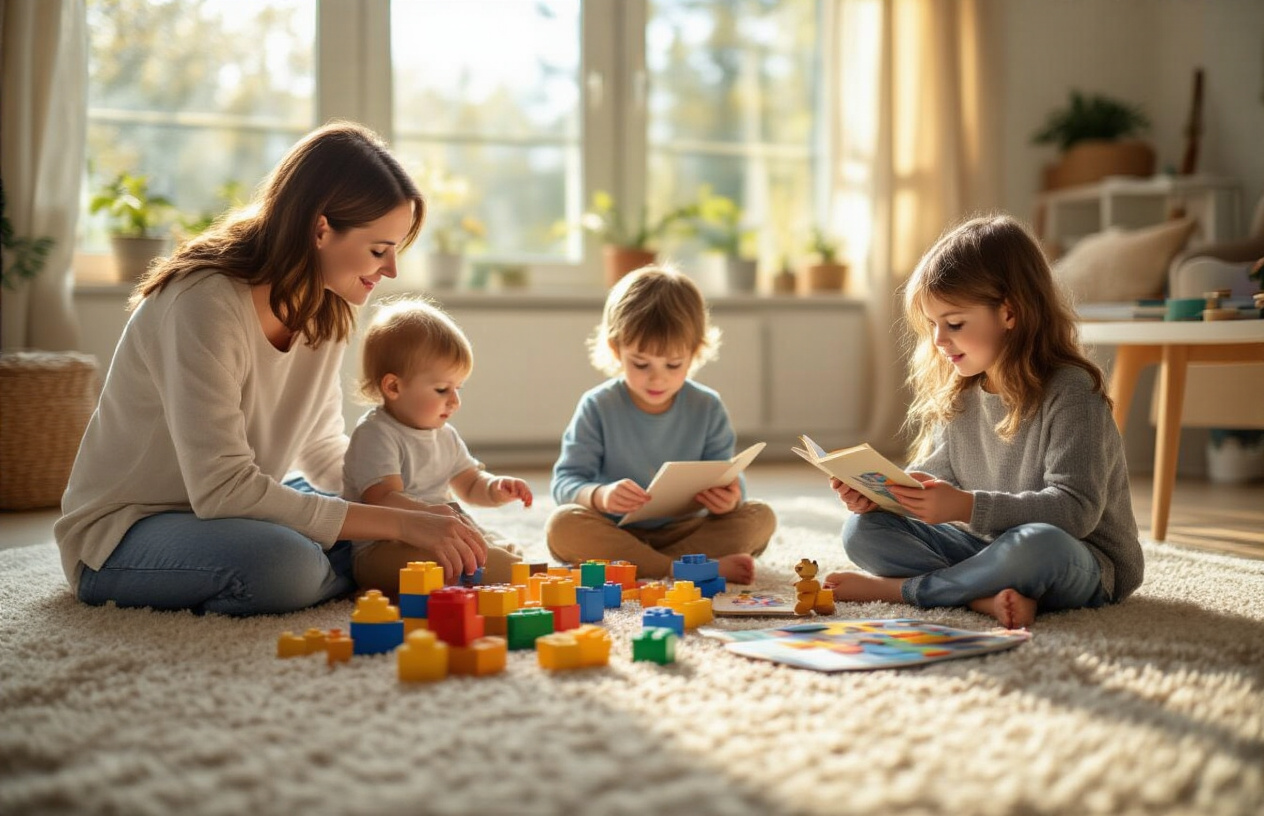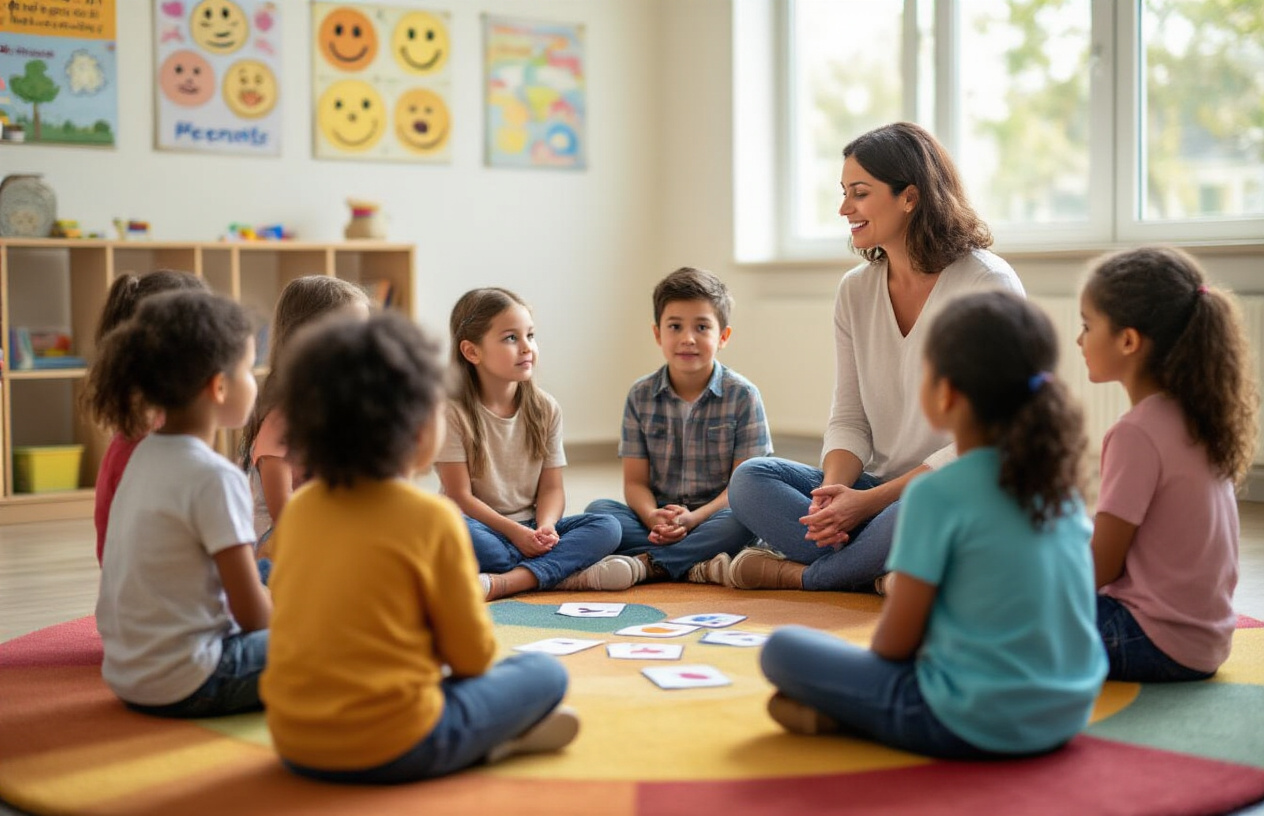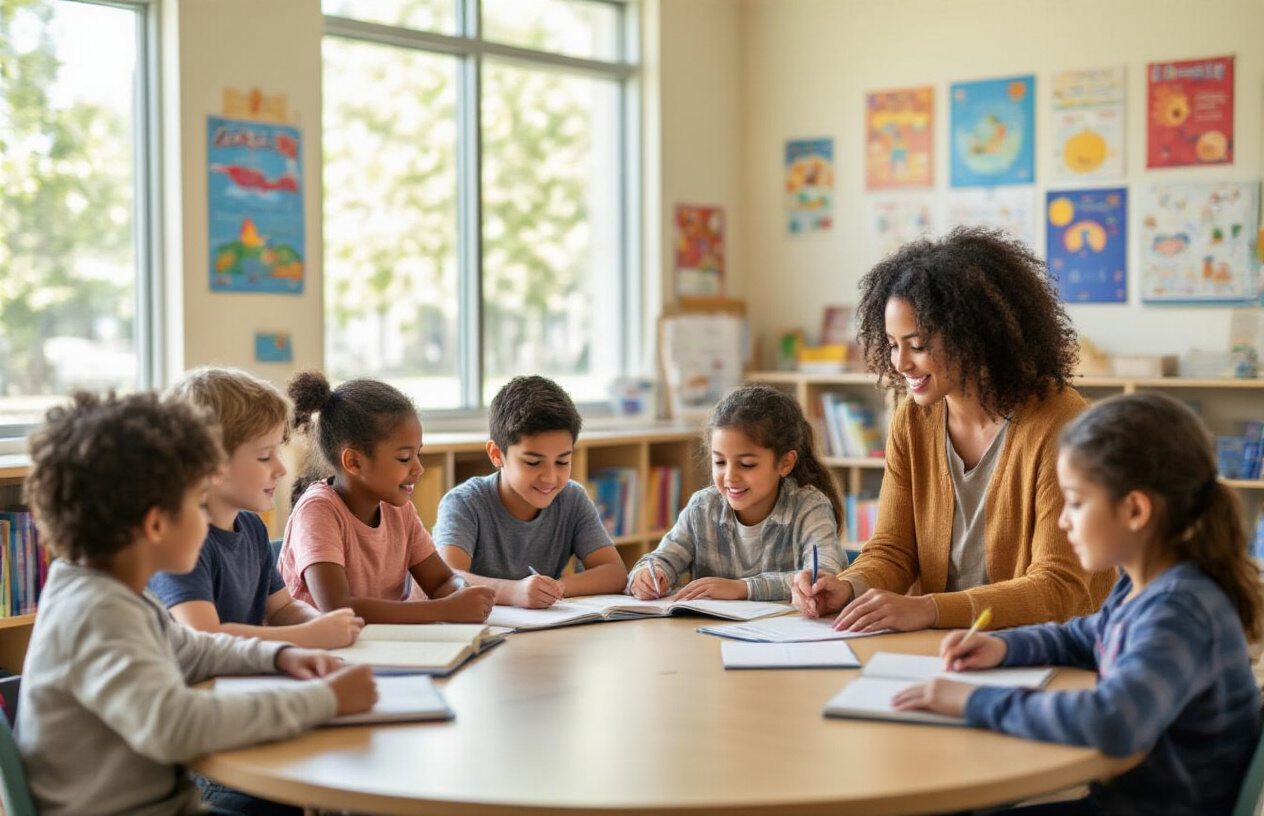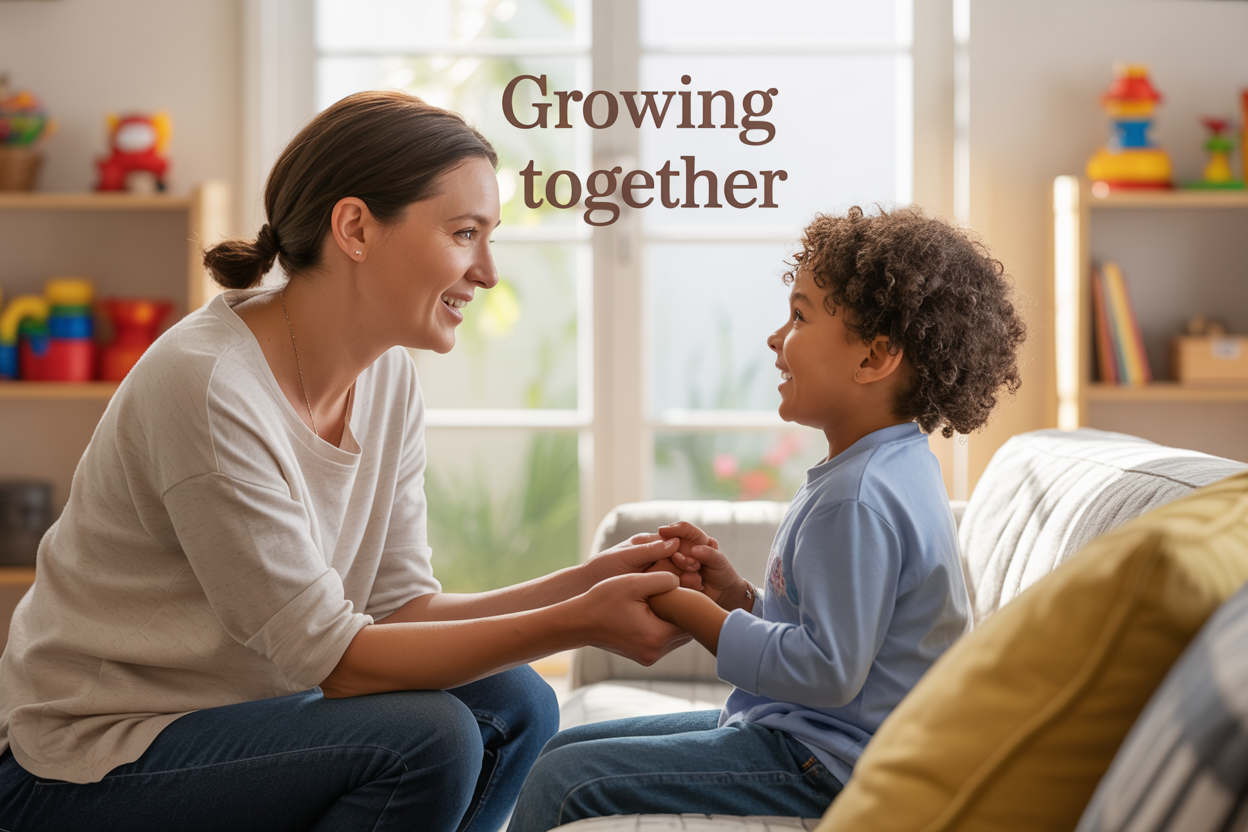Growing Together: A Parent’s Guide to Child Psychology
https://www.amazon.com/dp/9334261870 https://www.amazon.co.uk/dp/9334261870 https://www.amazon.fr/dp/9334261870
Parenting feels overwhelming when you can’t figure out why your 3-year-old has meltdowns or your 10-year-old suddenly becomes withdrawn. Child psychology gives you the roadmap to understand what’s happening in your child’s mind and how to respond in ways that build connection instead of conflict.
This guide is for parents, caregivers, and anyone raising children who wants to move beyond guesswork and develop practical parenting tips rooted in developmental science. You’ll discover why understanding child development stages helps you set realistic expectations, and how parent child communication becomes easier when you know what your child can actually handle at their age.
We’ll explore how to tackle those everyday behavioral challenges in children without losing your mind, plus simple ways to boost your child’s emotional intelligence for kids through daily interactions. You’ll also learn positive parenting strategies that work in real life – not just in parenting books – so you can raise emotionally intelligent children who feel secure and capable.
Ready to transform those frustrating moments into opportunities for deeper connection? Let’s dive into the fascinating world of your child’s developing mind.
Understanding Your Child’s Developmental Stages

Recognizing Key Cognitive Milestones by Age
Every child develops at their own pace, but understanding typical cognitive milestones helps you support your child’s growth effectively. During the toddler years (ages 2-3), watch for rapid language development, basic problem-solving skills, and the ability to follow simple two-step instructions. Your child might start asking “why” constantly – this curiosity signals healthy cognitive development in child psychology.
Preschoolers (ages 4-5) develop more complex thinking patterns. They begin understanding cause and effect, can focus on activities for longer periods, and start grasping basic math concepts like counting and sorting. Their imagination explodes during this stage, creating elaborate pretend play scenarios that actually strengthen cognitive development.
School-age children (ages 6-12) experience significant cognitive leaps. They develop logical thinking, understand abstract concepts like time and money, and can consider multiple aspects of a problem simultaneously. Their memory improves dramatically, and they start developing personal learning strategies.
During adolescence, the brain undergoes major restructuring. Teenagers develop advanced reasoning abilities, can think hypothetically, and begin forming their own moral judgments. However, the emotional centers of their brains mature faster than areas responsible for impulse control, explaining typical teenage behavior patterns.
Identifying Emotional Growth Patterns
Emotional development follows predictable patterns that every parent should recognize. Infants primarily express basic emotions like joy, anger, and distress. By 18 months, toddlers begin showing more complex emotions like embarrassment and pride, though they lack the vocabulary to express these feelings adequately.
The “terrible twos” aren’t just about defiance – they represent crucial emotional growth. Toddlers experience big feelings in small bodies without proper coping mechanisms. They’re learning emotional regulation, which explains the intense tantrums followed by quick recoveries.
Preschoolers start developing empathy and can recognize emotions in others. They begin understanding that actions have emotional consequences and start showing genuine concern for friends who are hurt or upset. This stage marks the beginning of emotional intelligence development.
School-age children refine their emotional vocabulary and start managing feelings more independently. They learn to hide emotions when socially appropriate and develop friendship skills. However, they still need guidance processing complex emotions like jealousy, disappointment, and frustration.
Teenagers face emotional intensity as hormones surge and identity formation begins. They experience mood swings, seek independence while craving security, and navigate complex peer relationships. Understanding these patterns helps parents respond with patience rather than frustration.
Supporting Physical Development Needs
Physical development directly impacts cognitive and emotional growth, making it crucial for overall child development stages. Babies need plenty of tummy time to strengthen neck and core muscles, laying the foundation for crawling, walking, and later athletic abilities.
Toddlers require safe spaces for active exploration. Their brains are wired for movement, and restricting physical activity can actually hinder cognitive development. Provide climbing opportunities, outdoor play, and varied textures to explore through touch.
Preschoolers benefit from both gross motor activities (running, jumping, biking) and fine motor skill development (drawing, cutting, building with small blocks). These activities strengthen hand-eye coordination essential for writing and academic success later.
School-age children need regular physical activity for optimal brain function. Exercise increases blood flow to the brain, improving concentration and memory. Sports and organized activities also teach valuable social skills and emotional regulation through physical challenges.
Adequate sleep becomes increasingly important as children grow. Sleep deprivation affects attention, mood regulation, and physical growth hormone release. Establish consistent bedtimes and limit screen time before bed to support healthy sleep patterns.
Nutrition plays a vital role in physical development. Growing brains need proper fuel – protein for neurotransmitter production, healthy fats for brain structure, and complex carbohydrates for steady energy. Involve children in meal planning to teach healthy eating habits while supporting their developmental needs.
Building Strong Communication Channels with Your Child

Active Listening Techniques That Work
Effective parent child communication begins with truly hearing what your child says. Active listening means putting down your phone, making eye contact, and giving your full attention when your child speaks. This simple act shows them their thoughts and feelings matter to you.
Try the reflection technique – repeat back what you heard in your own words. When your child says “My teacher was mean today,” respond with “Sounds like you had a tough time with your teacher. Can you tell me what happened?” This validates their experience and encourages them to share more details.
Avoid jumping straight into problem-solving mode. Children often need to vent before they’re ready for solutions. Let them express their emotions fully before offering advice. Use phrases like “That must have been frustrating” or “I can see why you’d feel that way” to acknowledge their feelings.
Watch your body language too. Lean in slightly, nod occasionally, and maintain an open posture. These non-verbal cues signal that you’re engaged and supportive.
Age-Appropriate Conversation Starters
Starting meaningful conversations with children requires tailoring your approach to their developmental stage. For preschoolers (ages 3-5), use simple, concrete questions about their immediate experiences. “What was your favorite part of playing today?” or “How did that make your tummy feel?” work well for this age group.
Elementary school children (ages 6-11) can handle more complex discussions. Try asking about their friendships, school experiences, or future dreams. Questions like “If you could teach the class about anything, what would it be?” spark their imagination while revealing their interests.
Teenagers need different strategies altogether. Direct questions often lead to one-word answers, so try indirect approaches. Share something from your own day first, then ask open-ended questions about their experiences. “I had this weird situation at work today… speaking of weird situations, how was your day?”
| Age Group | Effective Starters | Topics to Explore |
|---|---|---|
| 3-5 years | “Tell me about…” | Daily activities, feelings, favorites |
| 6-11 years | “What if…” questions | School, friendships, hobbies |
| 12+ years | Sharing first, then asking | Identity, values, future goals |
Creating Safe Spaces for Open Dialogue
Building trust takes time, but creating the right environment speeds up the process. Choose regular, relaxed moments for deeper conversations – car rides, bedtime, or while doing activities together work perfectly. These natural settings feel less intimidating than formal sit-down talks.
Establish family rules about communication early on. No interrupting, no judgment, and no immediate consequences for sharing feelings or mistakes. When children know they won’t face instant punishment for honesty, they’re more likely to open up about problems.
Physical spaces matter too. Some children talk more easily while walking, others prefer cozy spots like their bedroom or a favorite chair. Pay attention to where your child seems most comfortable and relaxed.
Timing plays a huge role in successful conversations. Avoid serious talks when anyone is hungry, tired, or stressed. Children are more receptive when they feel secure and calm. If your child brings up something important at an inconvenient moment, acknowledge it immediately but suggest a better time to discuss it fully.
Reading Non-Verbal Cues Effectively
Children communicate volumes through their body language, often before they can put feelings into words. Learning to read these signals helps you respond appropriately and shows your child that you truly see them.
Watch for changes in posture, facial expressions, and energy levels. A usually chatty child who becomes quiet might be processing something difficult. Crossed arms, avoiding eye contact, or fidgeting can signal discomfort or anxiety about a topic.
Sleep patterns, appetite changes, and social behaviors also provide important clues about your child’s emotional state. A child who suddenly stops wanting playdates or becomes clingy might be struggling with something at school or with friends.
Don’t assume you know what every gesture means – children’s non-verbal communication can vary widely based on personality and family culture. Instead, use what you observe as conversation starters. “I noticed you seemed upset after school. Want to talk about your day?” gives them permission to share without putting pressure on them.
Remember that your own non-verbal communication sends powerful messages too. Children pick up on parent stress, frustration, or distraction even when you think you’re hiding it well. Being mindful of your own body language helps create the open, supportive atmosphere that child psychology research shows is essential for healthy development.
Managing Common Behavioral Challenges

Addressing Tantrums and Meltdowns
Children’s emotional outbursts can feel overwhelming, but understanding the root causes makes all the difference. Tantrums typically happen when kids feel frustrated, tired, hungry, or simply lack the words to express their needs. Rather than viewing these moments as defiance, see them as communication attempts from a developing brain.
When your child melts down, stay calm yourself first. Your emotional regulation becomes their anchor during the storm. Get down to their eye level and use a gentle, steady voice. Acknowledge their feelings with phrases like “You’re really upset right now” or “This is hard for you.” Avoid trying to reason with them mid-tantrum – their logical brain isn’t online yet.
Create a consistent response plan. Some children need space to decompress, while others benefit from comfort. Learn your child’s patterns. After the storm passes, talk about what happened when they’re calm and receptive. Help them identify the trigger and brainstorm better ways to handle similar situations next time.
Prevention works better than intervention. Notice your child’s early warning signs – rubbing eyes when tired, becoming clingy when overwhelmed, or getting silly when overstimulated. Address these needs before they escalate into full meltdowns.
Setting Boundaries That Stick
Effective boundaries require consistency, not perfection. Children test limits because they’re naturally wired to understand their world’s structure. When you set a rule, expect pushback – it’s actually a healthy sign of normal development.
Make your expectations clear and age-appropriate. A three-year-old can’t follow complex multi-step rules, but they can understand “gentle hands” or “inside voices.” Use positive language when possible. Instead of “don’t run,” try “walking feet inside the house.” This gives children a clear action to take rather than just telling them what not to do.
Follow through matters more than harsh consequences. If you say “five more minutes,” stick to it. Use timers to help younger children understand time limits. When boundaries get crossed, respond promptly but calmly. Delayed consequences lose their teaching power, especially with younger kids.
Pick your battles wisely. Not every moment needs to be a teaching opportunity. Focus on safety issues and core family values. Let minor things slide when your child is having a rough day. This approach prevents constant power struggles and preserves your authority for what truly matters.
Dealing with Defiance and Testing Limits
Defiant behavior often signals your child is developing independence – a positive milestone wrapped in challenging packaging. When faced with outright refusal, pause before reacting. Ask yourself whether this is worth a battle and what your child might be trying to communicate.
Offer choices within boundaries. Instead of “Put on your shoes now,” try “Would you like to put on your shoes or carry them to the car?” This gives children some control while maintaining your ultimate goal. Most behavioral challenges in children stem from feeling powerless in their daily lives.
Connect before you correct. When your child pushes back, check in with their basic needs first. Are they hungry, tired, or feeling disconnected from you? Sometimes what looks like defiance is actually a bid for attention or help. Spend a few minutes giving them your full focus before addressing the behavior.
Stay curious rather than furious. When children repeatedly test the same boundary, there’s usually an unmet need underneath. Maybe they need more autonomy, clearer expectations, or simply more connection with you. Child behavior management becomes much easier when you play detective rather than police officer.
Remember that strong-willed children often become confident, capable adults. Channel that determination into positive directions by giving them leadership roles appropriate for their age. Let them help make family decisions, plan activities, or teach younger siblings. This transforms their natural assertiveness into a strength rather than a source of constant conflict.
Nurturing Emotional Intelligence in Children

Teaching Emotion Recognition and Naming
Children often feel overwhelmed by emotions they can’t identify. Picture your three-year-old having a meltdown in the grocery store – they’re experiencing frustration, disappointment, or even embarrassment, but lack the vocabulary to express these complex feelings.
Start by labeling emotions as they happen: “I see you’re feeling angry because your tower fell down” or “You look excited about going to the park!” Create emotion charts with faces showing different feelings, and make it a daily practice to check in with your child about their emotional state.
Reading books together provides perfect opportunities for emotion recognition. Pause during stories to ask, “How do you think the character feels right now?” This builds their emotional vocabulary while making the concept less abstract. Games like “emotion charades” or using emotion dice during family time make learning about feelings fun and memorable.
Developing Empathy Through Daily Interactions
Empathy grows through real-world practice, not lectures about being kind. When your child sees someone upset, guide them to notice: “Look at Sarah’s face. What do you think she might be feeling?” Help them connect their own experiences to others’ situations.
Model empathy in your own interactions. When you comfort a crying friend or help an elderly neighbor, narrate your thinking: “I’m bringing Mrs. Johnson soup because she’s not feeling well. That’s what friends do for each other.”
Role-playing different scenarios builds empathy muscles. Act out situations like a new student feeling left out or a sibling being disappointed. Ask your child how they would feel in that position and what might help. These conversations plant seeds of compassion that bloom into genuine care for others.
Create family traditions around kindness – maybe writing thank-you notes together or volunteering as a family. These shared experiences teach children that thinking of others isn’t just nice, it’s a way of life.
Building Resilience Against Life’s Challenges
Resilience isn’t about avoiding difficulties – it’s about bouncing back from them. Children need to experience manageable challenges to develop this crucial skill. When your child struggles with a puzzle, resist the urge to immediately help. Instead, offer encouragement: “This is tricky, but I’ve seen you figure out hard things before.”
Share stories from your own childhood about times you faced setbacks and recovered. Kids love hearing about when mom or dad made mistakes or felt scared. These stories normalize struggle and show that everyone faces challenges.
Create a “problem-solving toolkit” with your child. When issues arise, walk through steps together: identify the problem, brainstorm solutions, try one approach, and evaluate the results. This systematic approach gives children confidence that problems can be solved.
Celebrate effort over outcome. Instead of “You’re so smart!” try “I noticed how you kept trying different strategies until you found one that worked.” This builds what psychologists call a growth mindset – the belief that abilities can be developed through dedication and hard work.
Encouraging Healthy Emotional Expression
Every emotion serves a purpose, even the uncomfortable ones. Anger alerts us to unfairness, sadness helps us process loss, and fear keeps us safe. Teaching children that all feelings are valid while helping them express emotions appropriately is key to raising emotionally intelligent children.
Create safe spaces for big emotions. Designate a cozy corner with soft pillows where children can go when they need to feel their feelings. Some families use a “feelings thermometer” to help kids communicate their emotional intensity levels.
Physical outlets help children process emotions naturally. Dancing to favorite songs, running around the backyard, or even punching pillows can help release built-up emotional energy. Art supplies, journals, and musical instruments offer creative emotional outlets.
Establish family rules about emotional expression: “All feelings are okay, but hurting others isn’t.” When children express emotions inappropriately, redirect rather than punish: “I can see you’re frustrated, but hitting isn’t okay. Let’s find a better way to show those big feelings.”
Regular family meetings provide structured opportunities for emotional check-ins. Go around the table sharing highlights and challenges from the week. This normalizes talking about feelings and strengthens family bonds through emotional connection.
Supporting Academic and Social Success

Creating Effective Study Environments
Your child’s study space can make or break their learning experience. Think of it like setting up a workshop – you need the right tools and atmosphere to get quality work done. Start with a dedicated area that’s free from distractions like TV, gaming devices, or high-traffic zones. This doesn’t mean you need a fancy home office – even a corner of the dining table works if it’s consistently theirs during homework time.
Lighting matters more than most parents realize. Natural light is best, but a good desk lamp prevents eye strain and keeps your child alert. Keep supplies organized in bins or drawers so your child doesn’t waste time hunting for pencils or erasers. Consider noise levels too – some kids focus better with complete silence, while others work well with soft background music.
The key is involving your child in creating this space. When they help choose the setup, they feel ownership and are more likely to use it effectively. Remember, what works for one child might not work for another, even within the same family.
Building Peer Relationship Skills
Social skills don’t always come naturally, especially in our digital age where face-to-face interaction takes practice. Start by teaching your child how to read social cues – body language, tone of voice, and facial expressions. Role-play different scenarios at home, like joining a group conversation or handling disagreements with friends.
Encourage your child to participate in group activities like sports teams, clubs, or community programs. These settings provide natural opportunities to practice cooperation, sharing, and compromise. When conflicts arise with peers, resist the urge to jump in immediately. Instead, coach your child through problem-solving steps: understanding the other person’s perspective, finding common ground, and suggesting solutions.
Teaching empathy is crucial for building strong friendships. Help your child recognize emotions in themselves and others by discussing feelings openly at home. Books and movies offer great conversation starters about different social situations and how characters handle them.
Boosting Self-Confidence in Learning
Academic confidence grows when children experience success and feel supported through challenges. Break difficult tasks into smaller, manageable steps so your child can celebrate progress along the way. When they struggle with math problems, don’t just give them the answer – guide them to discover it themselves.
Focus on effort over results. Instead of saying “You’re so smart!” try “I noticed how hard you worked on that project.” This builds a growth mindset where children see abilities as skills they can develop rather than fixed traits. When mistakes happen, frame them as learning opportunities rather than failures.
Create opportunities for your child to teach others – maybe they help a younger sibling with reading or explain a concept they’ve mastered. Teaching reinforces their own learning while building confidence in their abilities. Also, connect learning to your child’s interests. A child fascinated by dinosaurs might tackle challenging reading through paleontology books.
Handling School-Related Stress and Anxiety
School anxiety shows up differently in every child – some get stomachaches, others become clingy or irritable. Pay attention to changes in behavior, sleep patterns, or appetite around school time. Create a safe space where your child can express worries without judgment.
Establish predictable routines that reduce uncertainty. Morning and bedtime routines help children feel secure and prepared for the school day. When your child shares specific concerns, take them seriously even if they seem minor to you. Their feelings are real and valid.
Teach simple relaxation techniques like deep breathing or progressive muscle relaxation. Practice these during calm moments so your child can use them when stress hits. Sometimes school anxiety stems from academic pressure, social issues, or learning differences that need professional attention. Don’t hesitate to communicate with teachers or seek help from school counselors when needed.
Encouraging Independence in Problem-Solving
Independence grows when children practice making decisions and solving problems on their own. Start with age-appropriate choices – what to wear, which homework assignment to tackle first, or how to organize their backpack. As they demonstrate good judgment, gradually expand their decision-making opportunities.
When your child faces a problem, ask open-ended questions instead of providing immediate solutions: “What do you think might work?” or “What would happen if you tried that?” This develops critical thinking skills and builds confidence in their ability to handle challenges.
Allow natural consequences to teach lessons when safe to do so. If your child forgets their lunch, they might need to eat the school meal instead of having you rush it over. These experiences build responsibility and help children connect their choices to outcomes. Balance this with appropriate support – you’re building independence, not abandoning them to figure everything out alone.
Applying Positive Parenting Strategies

Using Praise and Rewards Effectively
Positive parenting strategies work best when praise becomes specific and meaningful rather than generic. Instead of saying “good job,” try “I noticed how patiently you waited your turn at the playground – that showed great self-control.” This approach helps children understand exactly what behavior you’re reinforcing.
Timing matters enormously with praise. Catch your child in the moment of positive behavior rather than waiting hours later. The connection between action and recognition strengthens the neural pathways that support good choices.
Reward systems should focus on effort over outcome. A child who struggles with reading benefits more from praise about sitting quietly for ten minutes with a book than from rewards tied to reading level achievements. This builds intrinsic motivation and resilience.
Consider non-material rewards that build connection: extra story time, choosing the family movie, or helping prepare dinner. These experiences create positive associations with good behavior while strengthening your relationship.
Avoid over-praising, which can create praise-dependent children who struggle with self-motivation. Balance specific praise with quiet acknowledgment – sometimes a smile or nod communicates approval without making the child feel like they’re performing for attention.
Implementing Natural Consequences
Natural consequences teach children about cause and effect without you playing the role of enforcer. When your child forgets their homework, they experience the natural result at school rather than facing additional punishment at home. This approach supports child development stages by allowing kids to learn from real-world feedback.
The key lies in stepping back when safe to do so. A child who refuses to wear a coat experiences being cold – a natural teacher that’s often more effective than arguments about weather. Your role becomes supportive rather than controlling: “I see you’re chilly. Your jacket is in the car if you’d like it.”
Distinguish between natural and logical consequences. Natural consequences happen without your intervention, while logical consequences are imposed by you but directly related to the behavior. Both have their place in positive parenting strategies.
Safety always trumps natural consequences. Don’t allow dangerous situations to unfold for learning purposes. Use your judgment about which battles are worth the natural consequence approach.
Sometimes natural consequences take time to unfold. A child who doesn’t study may not see grade impacts immediately, requiring you to trust the process while offering support when they’re ready to make different choices.
Modeling the Behavior You Want to See
Children learn more from watching than listening. Your emotional regulation during stress teaches them emotional intelligence for kids far more effectively than any lecture about staying calm. When you handle frustration with deep breathing and problem-solving, you’re demonstrating practical life skills.
Child behavior management starts with self-management. Notice your own patterns: Do you raise your voice when overwhelmed? Do you use kind words when things don’t go your way? Kids absorb these patterns and replay them in their own interactions.
Model the communication style you want to see. Speak to your child the way you’d want them to speak to others. Use “please” and “thank you” consistently. Show curiosity instead of judgment when they make mistakes: “What happened here? How can we fix this together?”
Demonstrate healthy relationships through your interactions with partners, friends, and even service workers. Children notice how you treat the cashier at the grocery store or respond to a friend’s phone call. These moments shape their understanding of respect and kindness.
Own your mistakes openly. When you lose your temper or make a poor choice, acknowledge it: “I shouldn’t have yelled earlier. I was frustrated about work, but that’s not your fault. I’m sorry.” This teaches accountability and shows that everyone continues learning throughout life.
Your consistency between public and private behavior matters tremendously. Children quickly notice if you act differently around others than you do at home, and this can undermine trust and your modeling efforts.

Every child grows at their own pace, but understanding the basic stages of development, building open lines of communication, and handling behavioral challenges with patience creates a foundation for healthy parent-child relationships. When you focus on nurturing your child’s emotional intelligence while supporting their academic and social growth, you’re giving them tools they’ll use for life.
The journey of parenting doesn’t come with a manual, but applying positive parenting strategies and staying connected with your child’s world makes all the difference. Remember that small, consistent efforts in understanding your child’s needs and responding with empathy will strengthen your bond and help them thrive. Trust yourself as a parent while staying open to learning alongside your child as they grow.








